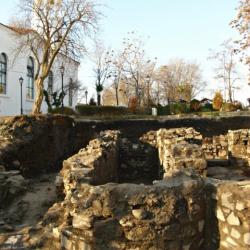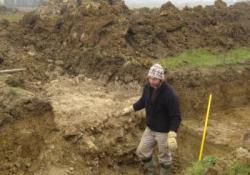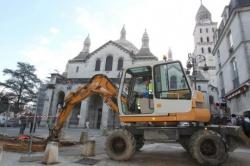INSTITUT SUPERIEUR D'ANTHROPOLOGIE
INSTITUTE OF ANTHROPOLOGY
ONLINE COURSES / COURS A DISTANCE
OPEN COURSE : FEBRUARY 2013
HRM 104 : INTRODUCTION TO INTANGIBLE CULTURAL HERITAGE
REGISTER NOW
TURQUIE –  Konya - During works carried out in the Central Anatolian province of Konya, three glass bracelets from the early Roman era have been unearthed. The excavations are being conducted in the Meram and Selçuklu districts of Konya, as well as in the Gökyurt village and the Kızılören neighborhood within the borders of the city. A number of Roman and Byzantine architectural works have been found in the excavations so far, as well as the three glass bracelets, according to officials. The head of the excavations, Professor Ali Boran said they had found the bracelets inside a mound in Gökyurt. He said the bracelets were made of black opaque glass material and that similar examples showed that they were from 5th and 7th centuries. The bracelets have been delivered to the Konya Archaeology Museum.
Konya - During works carried out in the Central Anatolian province of Konya, three glass bracelets from the early Roman era have been unearthed. The excavations are being conducted in the Meram and Selçuklu districts of Konya, as well as in the Gökyurt village and the Kızılören neighborhood within the borders of the city. A number of Roman and Byzantine architectural works have been found in the excavations so far, as well as the three glass bracelets, according to officials. The head of the excavations, Professor Ali Boran said they had found the bracelets inside a mound in Gökyurt. He said the bracelets were made of black opaque glass material and that similar examples showed that they were from 5th and 7th centuries. The bracelets have been delivered to the Konya Archaeology Museum.
http://www.hurriyetdailynews.com/roman-bracelets-found-in-central-anatolia.aspx?pageID=238&nID=41133&NewsCatID=375
BULGARIE –  Sozopol - A Bulgarian team of archaeologists have discovered well-preserved remains of a Roman bath in the ancient Bulgarian town of Sozopol. The news was revealed by National Museum of History director Bozhidar Dimitrov. "The team, led by Sozopol Archaeology Museum director Dimitar Nedev has made the discovery as part of its digs in the area in front of Sozopol's fortress walls," said the historian. According to Dimitrov, the thermae building is 18 meters long and features an intricate water supply systems as well as numerous pools of various sizes. "Except for Roman baths in Hissarya and Varna, this is the best-preserved Roman bath in Bulgarian lands," added he. Dimitrov expressed satisfaction at the string of discoveries made in Sozopol, which he said will make an attractive open-air exhibit once archaeological works are completed. Sozopol, founded by Greek colonists in the 5th century BC on what is now Bulgaria's southern Black Sea coast, is now a popular resort town.
Sozopol - A Bulgarian team of archaeologists have discovered well-preserved remains of a Roman bath in the ancient Bulgarian town of Sozopol. The news was revealed by National Museum of History director Bozhidar Dimitrov. "The team, led by Sozopol Archaeology Museum director Dimitar Nedev has made the discovery as part of its digs in the area in front of Sozopol's fortress walls," said the historian. According to Dimitrov, the thermae building is 18 meters long and features an intricate water supply systems as well as numerous pools of various sizes. "Except for Roman baths in Hissarya and Varna, this is the best-preserved Roman bath in Bulgarian lands," added he. Dimitrov expressed satisfaction at the string of discoveries made in Sozopol, which he said will make an attractive open-air exhibit once archaeological works are completed. Sozopol, founded by Greek colonists in the 5th century BC on what is now Bulgaria's southern Black Sea coast, is now a popular resort town.
http://www.novinite.com/view_news.php?id=147946
ITALIE –  Florence - A British academic has stumbled upon a 500-year-old "most wanted" notice for the arrest of Niccolo Machiavelli, the infamous Renaissance political operator who wrote The Prince. Prof Stephen Milner from Manchester University discovered the historic document by accident while researching town criers and the proclamations they read out in archives in Florence. The 1513 proclamation, which called for the arrest of Machiavelli, eventually led to his downfall and death. When the Medici family returned to power in Florence in 1512, Machiavelli was removed from his post in the city's chancery because of his association with the head of a rival faction. His name was then linked with a conspiracy to overthrow the Medici. They issued the proclamation found by Prof Milner for his arrest. "On the same day, he was imprisoned, tortured and later released and placed under house arrest outside the city," said the historian, an authority on Renaissance Italy. Machiavelli, known as the Prince of Darkness, then wrote The Prince in the hope of regaining the approval of the Medicis. Machiavelli's fortunes spiralled downwards and he died in abject poverty 14 years later. The academic found the document while studying hundreds of town crier proclamations issued between 1470 and 1530. He also found documents relating to the payment of four horsemen who scoured the streets of the Tuscan city for Machiavelli.
Florence - A British academic has stumbled upon a 500-year-old "most wanted" notice for the arrest of Niccolo Machiavelli, the infamous Renaissance political operator who wrote The Prince. Prof Stephen Milner from Manchester University discovered the historic document by accident while researching town criers and the proclamations they read out in archives in Florence. The 1513 proclamation, which called for the arrest of Machiavelli, eventually led to his downfall and death. When the Medici family returned to power in Florence in 1512, Machiavelli was removed from his post in the city's chancery because of his association with the head of a rival faction. His name was then linked with a conspiracy to overthrow the Medici. They issued the proclamation found by Prof Milner for his arrest. "On the same day, he was imprisoned, tortured and later released and placed under house arrest outside the city," said the historian, an authority on Renaissance Italy. Machiavelli, known as the Prince of Darkness, then wrote The Prince in the hope of regaining the approval of the Medicis. Machiavelli's fortunes spiralled downwards and he died in abject poverty 14 years later. The academic found the document while studying hundreds of town crier proclamations issued between 1470 and 1530. He also found documents relating to the payment of four horsemen who scoured the streets of the Tuscan city for Machiavelli.
http://www.telegraph.co.uk/news/worldnews/europe/italy/9871527/Briton-finds-500-year-old-arrest-warrant-for-Machiavelli.html
ROYAUME UNI –  Dartmoor - A find hailed as "one of the most significant of at least the last 100 years", has unearthed human remains and Bronze Age artefacts thought to be 4,000 years old. The discovery, described by researchers as 'amazing', has given archaeologists an insight into the lives of people who lived on the rugged south western moorland 4,000 years ago. Organic remains, found in August 2011, include cremated human bones wrapped in a type of animal hide. The find also includes what appears to be intricately designed jewellery and textiles. Among the items discovered was an animal pelt, which contained what is believed to be a bracelet covered in tin beads. The objects, including teeth, textiles and jewellery, had been preserved in peat and were discovered in a burial chest on the moor. The find has been hailed as one of the most significant historical discoveries in a century. The artifacts were uncovered within a granite tomb-like casing known as a cist, and are made from materials not discovered in Britain at the time and hint - for the first time, the researchers say - at trading links between the area and the continent. Jane Marchand, senior archaeologist with the Dartmoor National Park, said the haul was among the most significant since the 19th century. "These artifacts, which are believed to be made from shale and amber, show that perhaps Dartmoor wasn't quite the isolated, hard-to-reach place we all thought it was 4,000 years ago.
Dartmoor - A find hailed as "one of the most significant of at least the last 100 years", has unearthed human remains and Bronze Age artefacts thought to be 4,000 years old. The discovery, described by researchers as 'amazing', has given archaeologists an insight into the lives of people who lived on the rugged south western moorland 4,000 years ago. Organic remains, found in August 2011, include cremated human bones wrapped in a type of animal hide. The find also includes what appears to be intricately designed jewellery and textiles. Among the items discovered was an animal pelt, which contained what is believed to be a bracelet covered in tin beads. The objects, including teeth, textiles and jewellery, had been preserved in peat and were discovered in a burial chest on the moor. The find has been hailed as one of the most significant historical discoveries in a century. The artifacts were uncovered within a granite tomb-like casing known as a cist, and are made from materials not discovered in Britain at the time and hint - for the first time, the researchers say - at trading links between the area and the continent. Jane Marchand, senior archaeologist with the Dartmoor National Park, said the haul was among the most significant since the 19th century. "These artifacts, which are believed to be made from shale and amber, show that perhaps Dartmoor wasn't quite the isolated, hard-to-reach place we all thought it was 4,000 years ago.
http://www.independent.co.uk/news/science/archaeology/one-of-the-most-significant-findings-of-the-last-100-years-artefacts-discovered-on-dartmoor-hint-at-ancient-trading-links-8499039.html
FRANCE – Melle - La technologie a volé au secours des fouilleurs. Une structure empierrée d’une quarantaine de mètres de large est bien là, sous la place Bujault . Lors des travaux entrepris par la municipalité pour la replantation de tilleuls, un engin, puis les bénévoles de la société archéologique du mellois, avaient mis au jour ce qui ressemblait fort un morceau de mur, dont l'épaisseur et le mode de construction laissait penser qu'on avait trouvé là, enfin, les traces du fameux château de Melle. S'il était inconcevable de défoncer toute la place pour tenter de trouver d'autres vestiges, la municipalité n'a pas pour autant abandonné l'idée d'en savoir davantage. Elle a donc fait appel au service de prospection géophysique de l'université de La Rochelle. « Même si l'étude montrait la présence de beaux vestiges, prévient le maire Yves Debien, la Ville n'a pas l'intention de creuser davantage. Nous voulons juste savoir ce qu'il y a et en tenir compte lors de prochains travaux ». Adrien Camus a donc parcouru la semaine passée l'ensemble de la place, vidée de tout véhicule. A l'aide d'un appareillage bardé d'électronique, il a pu mesurer en une multitude de points les perturbations du champ magnétique et en déduire la nature du sous-sol, cela à différents niveaux de profondeur. Prospection fructueuse puisque les données, en partie traitées aussitôt, lui ont permis de montrer sur place une première carte. « Il y a des structures empierrées qui apparaissent formant un U d'une quarantaine de mètres de large, avec un côté proche de l'allée centrale, une branche qui se dirige vers les halles et une autre vers les toilettes publiques ».
http://www.lanouvellerepublique.fr/Deux-Sevres/Actualite/24-Heures/n/Contenus/Articles/2013/02/18/Un-grand-U-sous-la-place-Bujault-1339756
FRANCE –  Sainte Colombe de Villeneuve - Surprise pour le requérant d'une demande de permis de construire à Sainte-Colombe-de-Villeneuve, sur le plateau, au niveau du lieu-dit Bel Air. Certes, il était de notoriété publique que ce site renferme dans son sous-sol des vestiges ou plus précisément des restes d'une villa ou ferme gallo-romaine. Mais de là à voir arriver des archéologues, c'est toute une histoire… Pourtant c'est bien ce qui s'est passé. Trois jours de fouilles ont été accordés à MM. Ducourneau et Tréguet, de l'INRAP. Leurs découvertes pour l'instant portent sur des murs épais de pierres, d'innombrables tuileaux, des poteries et une anse d'amphore. Elles leur permettront de procéder à des études et à l'élaboration d'un rapport circonstancié et «fouillé» destiné à une commission adhoc qui déterminera si ce site de Bel-Air présente un intérêt historique et archéologique tel qu'il convient de poursuivre les investigations engagées.
Sainte Colombe de Villeneuve - Surprise pour le requérant d'une demande de permis de construire à Sainte-Colombe-de-Villeneuve, sur le plateau, au niveau du lieu-dit Bel Air. Certes, il était de notoriété publique que ce site renferme dans son sous-sol des vestiges ou plus précisément des restes d'une villa ou ferme gallo-romaine. Mais de là à voir arriver des archéologues, c'est toute une histoire… Pourtant c'est bien ce qui s'est passé. Trois jours de fouilles ont été accordés à MM. Ducourneau et Tréguet, de l'INRAP. Leurs découvertes pour l'instant portent sur des murs épais de pierres, d'innombrables tuileaux, des poteries et une anse d'amphore. Elles leur permettront de procéder à des études et à l'élaboration d'un rapport circonstancié et «fouillé» destiné à une commission adhoc qui déterminera si ce site de Bel-Air présente un intérêt historique et archéologique tel qu'il convient de poursuivre les investigations engagées.
http://www.ladepeche.fr/article/2013/02/17/1562744-sainte-colombe-de-villeneuve-des-fouilles-archeologiques-au-lieu-dit-bel-air.html
FRANCE –  Périgueux - Depuis ce lundi et jusqu'à la fin de la semaine, trois points situés autour de la cathédrale de Périgueux vont être étudiés par les archéologues de l'Inrap. Ils ont débuté par une tranchée au bout de la rue de la Clarté et vont en creuser deux autres sur le parvis et au bout de la rue du Plantier. En descendant vers 1,5 mètre de profondeur ils vont explorer le sous-sol de ce secteur où se situait une ancienne nécropole ainsi que des bâtiments attenants à la cathédrale. L'an dernier, des sondages équivalents à quelques dizaines de mètres de la place de la Clautre avaient révélé plusieurs niveaux de sarcophages.
Périgueux - Depuis ce lundi et jusqu'à la fin de la semaine, trois points situés autour de la cathédrale de Périgueux vont être étudiés par les archéologues de l'Inrap. Ils ont débuté par une tranchée au bout de la rue de la Clarté et vont en creuser deux autres sur le parvis et au bout de la rue du Plantier. En descendant vers 1,5 mètre de profondeur ils vont explorer le sous-sol de ce secteur où se situait une ancienne nécropole ainsi que des bâtiments attenants à la cathédrale. L'an dernier, des sondages équivalents à quelques dizaines de mètres de la place de la Clautre avaient révélé plusieurs niveaux de sarcophages.
http://www.sudouest.fr/2013/02/18/des-fouilles-archeologiques-autour-de-saint-front-970511-1980.php
SYRIE –  At least 18 ancient mosaics depicting scenes from Homer’s “The Odyssey” have been stolen in northern Syria, the culture minister was quoted as saying on Sunday. “These mosaics were stolen during illegal excavations” on archaeological sites in the war-torn country’s northeast, Lubana Mushaweh said in an interview published on Sunday by the government daily Tishreen. “We have been informed that these mosaics are now on the Syrian-Lebanese border,” she said without elaborating.
At least 18 ancient mosaics depicting scenes from Homer’s “The Odyssey” have been stolen in northern Syria, the culture minister was quoted as saying on Sunday. “These mosaics were stolen during illegal excavations” on archaeological sites in the war-torn country’s northeast, Lubana Mushaweh said in an interview published on Sunday by the government daily Tishreen. “We have been informed that these mosaics are now on the Syrian-Lebanese border,” she said without elaborating.
http://www.rawstory.com/rs/2013/02/17/ancient-mosaics-of-the-odyssey-stolen-from-syrian-museum/